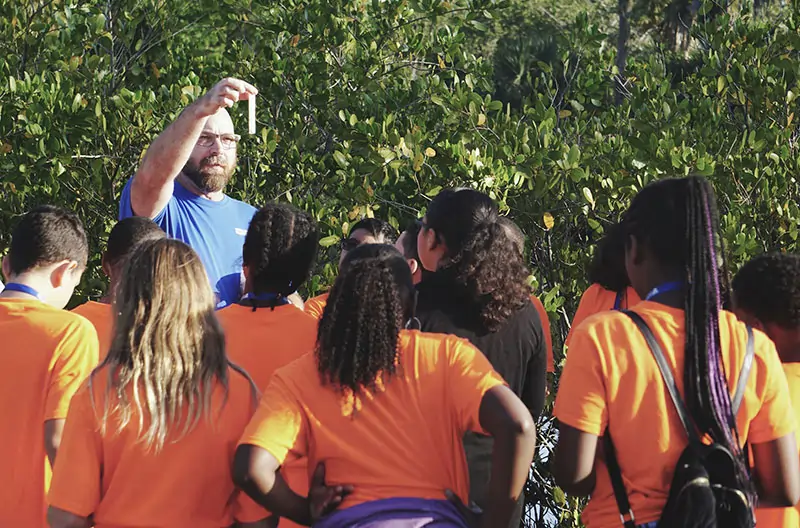A Beginner’s Guide to Outdoor Education: Tips and Examples

Amidst the trees in a tranquil forest, you could hear even the soft descent of a pine needle. Here, thirty children are seated in quiet contemplation. Some are lost in their musings, while others etch their thoughts onto bits of scrap paper. Remarkably, this scene unfolds on a still January day, with the temperature holding steadfast at five degrees below zero.
The entire experience has an enchanting quality, perfectly remembered by everyone. This experiential learning is one of the best ways to help students learn better. Indeed, you can never deny the benefits of outdoor education.
Make Learning Unforgettable
When reflecting on your school days, your most vivid recollections likely revolve around outdoor experiences. These memories often include field trips, excursions, and moments with nature. Interestingly, students tend to retain more of these outdoor activities.
These recollections are significant for two compelling reasons. First, it’s the teacher’s responsibility to conduct lessons in an environment that fosters effective learning in immediate and long-term contexts.
If outdoor experiences leave a more indelible mark on students, leveraging this method could assist them in retaining the knowledge they acquire. Second, students delve into why these memories are so enduring. What aspects of being outdoors contribute to embedding an event in their memory?
An event or experience doesn’t necessarily have to encompass all the principles applicable to learning indoors or outdoors. However, these principles align seamlessly with outdoor settings. Students remember the outdoors easier for the following reasons:
- Simplicity: Often, less can translate to more. Many outdoor activities make use of resources readily available on-site and tap into participants’ creative potential.
- Unforeseen: Outdoor activities frequently come with unexpected interruptions. A curious cat might stroll through the playground, or a trail of ants could suddenly pique children’s curiosity. Instead of derailing the lesson, view these interruptions as integral components of the experience. Embrace spontaneity and adapt, as an alternative learning objective can readily replace the original one.
- Tangible: Outdoor encounters often establish real connections with actual events, people, and the surrounding community. Practical skills are often necessary, imbuing learning with authenticity and practicality.
- Credible: Engaging with the outdoors resonates with children’s lives and curiosities. The outdoors provide a multisensory environment, enabling children to gain insights through various senses.
- Emotional: This element encapsulates the reactions of “ooh,” “ah,” and “ugh.” Not every moment spent outside is delightful, but when you hear these exclamations from your students, you recognize a profound connection forming. Learning is as much an emotional process as a cognitive one.
- Narratives: Forming narratives around outdoor experiences is relatively effortless. In contrast, constructing a compelling narrative while seated and completing a page of work in a textbook can be more challenging. Stories can act as a launching pad for outdoor activities; crafting and acting out stories become feasible. Adventures are often remembered as narratives. Bearing these principles in mind when designing outdoor experiences can enhance the memorability of the learning process.
Why is learning in outdoor settings necessary?
Adults who engage with youngsters can share their personal stories about the joy, liberation, creativity, and motivation that outdoor experiences provide. The advantages of learning outdoors have been acknowledged and recorded as far back as the fourteenth century.
Over the last two to three decades, considerable research has consistently indicated that humans require nature for basic survival and optimal well-being. Our cognitive, social, emotional, and physical health is influenced by our time outdoors, particularly in natural environments.
It is the reason behind the increasing emphasis on incorporating natural spaces like beaches and woodlands into educational settings. Additionally, transforming school grounds to include more plant life and promote wildlife benefits children’s overall wellness.
Examples of Outdoor Learning
Some outdoor activities that students enjoy include nature-inspired writing, drama storytelling, interactive read-aloud sessions, and nature journaling. Here are more outdoor education tips and examples.
Engaging students in the performance of brief plays or scenes from longer literary works sparks conversations about the experience of enacting Shakespearean pieces in an outdoor environment.
These discussions explore the nuances of context and setting, shedding light on how they influence performance. These dialogues also correlate with classroom studies of Greek amphitheaters and essential acting techniques, comprehensively exploring theatrical history and practice.
Engaging in outdoor read-aloud sessions, particularly with literature about nature, such as books, poems, or short stories, deepens our connection to the natural environment. It also exposes students to new literary works.
It’s also best to encourage students to take turns reading aloud. They are often more willing to share outdoors than in the classroom. As they gather around the flagpole, alternating reading from your chosen text, let them forge a connection with the setting. This method will also help them relate to one another, cultivating a sense of presence and active participation.
Tips To Make Outdoor Learning More Effective
Here are some tips on making learning outdoors more effective for your students.
Be patient and take small steps
Begin by taking small steps and maintaining patience. Embarking on outdoor teaching might be overwhelming. However, the encouraging aspect is that you can start with modest endeavors. You could hold morning meetings outdoors or dedicate a single day each week to outdoor activities with your students.
As you progressively allocate more time outdoors, you’ll gradually discern the essential requirements for a successful experience. These are necessities that you couldn’t have foreseen. It demands time and hands-on teaching experience to know what teaching aids are indispensable for your students to endure extended periods in the open-air classroom.
In essence, an outdoor learning area’s evolution and accompanying routines will necessitate time. They will be contingent on the specific demands of your class. Start with modest steps and be patient as you grow along the way.
Anchor the learning in the local environment
If vast forests and trails aren’t accessible to you, don’t worry. The essence of outdoor learning lies in connecting with the immediate surroundings. Ideally, outdoor education should be tied to a specific location, embracing hands-on, project-centered learning deeply intertwined with the local history, environment, culture, economy, literature, and art. Place-based education is adaptable to any setting.
Your students could engage in reading materials about local plant adaptations and explore the plant life thriving in the smallest of crevices. They could create maps highlighting nearby green spaces. They might even collaborate on an outdoor theatrical performance around a significant historical occurrence in the area.
They could also cultivate their garden or undertake a service learning initiative. Your students could also spread mulch in the garden of the town library. It could be beneficial to connect with other educators who emphasize nature-based education in settings similar to yours and draw inspiration from their approaches.
Maintain adaptability and ensure outdoor experiences are relatable
The natural world can be full of surprises, so it’s essential to stay open-minded and recognize that things may not always unfold as planned. The good news is you don’t need to possess the expertise of a wildlife biologist to engage your students in outdoor activities.
You don’t have to be a rain enthusiast to venture outside on a wet day. Display a positive outlook and be transparent about your knowledge and emotions with your students.
Statements like the following convey to your students that the learning journey is a collective one where everyone is progressing together:
- “I’m not entirely certain about the insect type”
- “How can we go about discovering it?”
- “I’m planning to wear my rain boots tomorrow since the weather forecast predicts rain”
- “I’m not a fan of having wet feet”

Related reading: Why Play Matters: A Deep Dive into the Benefits of Outdoor Activities for Children
Partner With Educators Who Share Your Vision
Remember that you don’t have to tackle this activity alone. Consider if any students have family members willing and capable of assisting in clearing a space within the forest. Are there community members with expertise in specific areas, such as knot tying or composting, who could contribute?
Involving others in diverse capacities within the outdoor learning process can foster a sense of community and enhance overall program engagement. Many inspiring learning initiatives and outdoor education resources are already underway. As you establish connections, you can visit other classrooms, participate in conferences, exchange resources, and engage in discussions.


